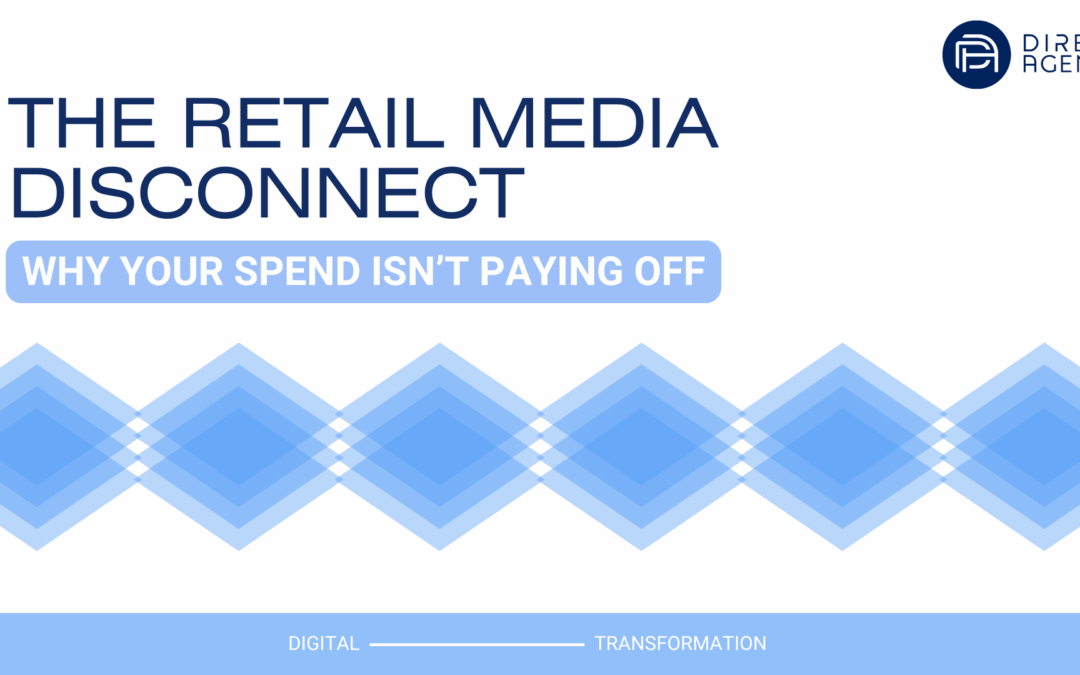Retail media networks like Amazon Ads, Walmart Connect, and Instacart Ads are capturing more marketing dollars than ever. Yet as budgets grow, so does the performance gap.
Once celebrated as closed-loop, high-ROAS machines, retail media is now leaving many marketers questioning its true impact. Costs per click are climbing, data is trapped in silos, and creative opportunities are often too constrained to build lasting brand equity.
In conversations with marketing leaders this year, one recurring scene emerges: CMOs defending ballooning retail media budgets in tense boardroom discussions, armed with fragmented reports that don’t tell the full story. U.S. retail media spend surpassed $54 billion in 2024, but for a growing number of marketers, returns aren’t keeping pace with investment.
The Shift
Over the past three years, retail media has moved from an experimental line item to a budget staple. Marketers have been drawn to its promise of high-intent audiences, first-party shopper data, and measurable sales impact. However, this acceleration has created a new reality. Cost per click rose roughly 10 percent year over year in early 2025, and in a recent analysis of 12 CPG brands, CPCs on one major network rose 18% YoY, yet only 3% of campaigns saw a matching lift in sales. Competition for premium placements has intensified, and network capabilities vary widely. While spending continues to grow, proving incremental value is becoming increasingly difficult.
The Challenge
Retail media’s operational promise is often undercut by three persistent friction points.
The first is siloed data. Each network operates its own closed reporting system, making it difficult to connect performance across retailers or integrate results into broader media mix modeling. Without a unified view, brands are left relying on incomplete insights when making investment decisions, making optimization harder.
The second challenge is rising costs. CPCs and media fees have steadily increased, and in many categories, brands are now paying significantly more for the same shelf space or impressions they secured a year ago. While costs climb, returns often plateau, eroding efficiency and placing greater pressure on profit margins.
The third challenge is limited creative control. Rigid ad formats, inconsistent off-platform integrations, and strict guidelines make campaigns feel interchangeable. This limits the ability to build long-term brand equity or tell a unique story within the retail media environment.
The result is brands chasing ROAS in a walled garden, investing more each year but struggling to create campaigns that stand out, integrate seamlessly, and deliver sustainable growth.
Efficiency is a Strategic Lever
Performance gaps don’t mean retail media should be abandoned. They signal a need for smarter systems. The most effective brands are not flooding networks with more creative or more budget. They are rethinking how creative, media, and measurement work together.
Efficiency in this context means building creative systems that work as hard as the media dollars behind them. That could look like modular assets designed to flex across different retail media formats without losing brand voice, automation and AI to streamline rapid versioning, and real-time integration of retail media data into omnichannel dashboards for a complete view.
Imagine a hero product video easily repurposed into a shoppable Amazon ad, a Walmart Connect carousel, and a TikTok-style off-site placement all built from the same core creative framework. This kind of adaptability not only reduces production waste but also strengthens brand consistency across touchpoints.
The Opportunity
When retail media is fully integrated into a brand’s broader marketing and sales ecosystem, it becomes more than a bottom-of-funnel channel. It evolves into a driver of awareness, loyalty, and growth across the customer journey.
Brands that connect retail media to upper-and mid-funnel activity see more efficient conversions, stronger repeat purchase rates, and faster optimization cycles. This comes from building campaigns designed for synergy, where creative, targeting, and measurement work in harmony across channels. The real opportunity is to stop treating retail media as a silo and start using it as a platform for storytelling, audience learning, and long-term brand building.
Winning Strategies in Action
Marketers seeing the strongest returns are taking deliberate, coordinated steps to close the gap between investment and impact. They integrate retail media planning with brand media to align messaging, targeting, and creative across the entire customer journey. They develop adaptable creative that maintains a strong brand voice while flexing to each network’s formats. They expand into off-site retail media channels such as connected TV, programmatic display, and paid social to influence shoppers earlier in their decision process. And they establish joint business plans with clear benchmarks for performance, transparency, and accountability before committing significant budgets.
These strategies position retail media as part of a connected growth system that drives both immediate results and long-term brand value.
The Road Forward
The future of retail media will not be defined by who spends the most, but by who spends the smartest. As the category matures, brands will need systems that bridge creative, media, and measurement from the start. The ones who win will be those who approach retail media with precision, adaptability, and a clear view of its role in the larger growth engine.
Direct Agents helps brands close the gap between investment and impact. We partner with in-house teams to design creative systems, align measurement frameworks, and scale retail media with agility.
If you’re rethinking how to make your retail media investment work harder, contact us at [email protected] to connect with one of our experts today.

